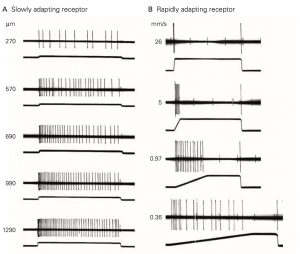5 Firing Rate Adaptation in Sensory Neurons
In response to a constant stimulus, most sensory receptors do not maintain a constant receptor potential, but rather one that declines over time. This process is called adaptation and is mediated by several different mechanisms in different receptors including changes in the behavior of the accessory structures, intracellular signal cascades and even changes in the threshold for generating action potentials at the axon hillock of the sensory neuron. Some sensory receptors adapt slowly to a constant stimulus and others adapt more rapidly. Slowly-adapting receptors are sometimes called tonic receptors because their sensory neurons maintain a tonic or sustained level of discharge as long as the stimulus is present. Likewise, rapidly-adapting sensory receptors are referred to as phasic receptors because they only discharge during specific phases of the stimulus, normally at the onset, but sometimes also at the offset. Tonic receptors are designed to signal the continued presence of a stimulus, whereas phasic receptors primarily signal the start time and end time of the stimulus. Many tissues, like skin and sense organs, like muscle spindles are innervated by both tonic and phasic receptors.

A. A slowly adapting mechanoreceptor responds as long as pressure is applied to the skin. The total number of action potentials discharged during the stimulus is proportional to the amount of pressure applied to the skin. The firing rate is higher at the beginning of skin contact than during steady pressure, as this receptor also detects how rapidly pressure is applied to the skin. When the probe is removed from the skin, the spike activity ceases.
B. A rapidly adapting mechanoreceptor responds at the beginning and end of the stimulus, signaling the rate at which the probe is applied and removed; it is silent when pressure is maintained at a fixed amplitude. Rapid motion evokes a brief burst of high-frequency spikes, whereas slow motion evokes a longer-lasting, low-frequency spike train.
